
FORTEACHERS ONLY
The University of the State of New York
REGENTS HIGH SCHOOL EXAMINATION
PS–ES PHYSICAL SETTING/EARTH SCIENCE
Wednesday, January 23, 2008 — 9:15 a.m. to 12:15 p.m., only
SCORING KEY AND RATING GUIDE
Directions to the Teacher:
Refer to the directions on page 3 before rating student papers.
Updated information regarding the rating of this examination may be posted on the New York
State Education Department’s web site during the rating period. Check this web site
http://www.emsc.nysed.gov/osa/ and select the link “Examination Scoring Information” for any
recently posted information regarding this examination. This site should be checked before the
rating process for this examination begins and several times throughout the Regents examination
period.
Part A and Part B–1
Allow 1 credit for each correct response.
Part A
Part B–1
1 . . . . . 2. . . . . . .
13 . . . . . 3. . . . . . .
25 . . . . 2. . . . . . .
36 . . . . . 2. . . . . . .
44 . . . . . 1. . . . . . .
2 . . . . . 3. . . . . . .
14 . . . . . 4. . . . . . .
26 . . . . 1. . . . . . .
37 . . . . . 2. . . . . . .
45 . . . . . 2. . . . . . .
3 . . . . . 4. . . . . . .
15 . . . . . 3. . . . . . .
27 . . . . 1. . . . . . .
38 . . . . . 3. . . . . . .
46 . . . . . 1. . . . . . .
4 . . . . . 3. . . . . . .
16 . . . . . 2. . . . . . .
28 . . . . 4. . . . . . .
39 . . . . . 4. . . . . . .
47 . . . . . 2. . . . . . .
5 . . . . . 3. . . . . . .
17 . . . . . 1. . . . . . .
29 . . . . 3. . . . . . .
40 . . . . . 1. . . . . . .
48 . . . . . 1. . . . . . .
6 . . . . . 2. . . . . . .
18 . . . . . 1. . . . . . .
30 . . . . 3. . . . . . .
41 . . . . . 2. . . . . . .
49 . . . . . 3. . . . . . .
7 . . . . . 2. . . . . . .
19 . . . . . 2. . . . . . .
31 . . . . 4. . . . . . .
42 . . . . . 4. . . . . . .
50 . . . . . 4. . . . . . .
Part B–1 Score
8 . . . . . 1. . . . . . .
20 . . . . . 3. . . . . . .
32 . . . . 4. . . . . . .
43 . . . . . 3. . . . . . .
9 . . . . . 3. . . . . . .
21 . . . . . 1. . . . . . .
33 . . . . 1. . . . . . .
10 . . . . . 1. . . . . . .
22 . . . . . 4. . . . . . .
34 . . . . 2. . . . . . .
11 . . . . . 1. . . . . . .
23 . . . . . 1. . . . . . .
35 . . . . 4. . . . . . .
Part A Score
12 . . . . . 3. . . . . . .
24 . . . . . 4. . . . . . .


P HYSICAL S ETTING/ E ARTH S CIENCE – continued
Directions to the Teacher
Follow the procedures below for scoring student answer papers for the Physical Setting/Earth
Science examination. Additional information about scoring is provided in the publication
Information Booklet for Scoring Regents Examinations in the Sciences .
Use only red ink or red pencil in rating Regents papers. Do not correct the student’s work by
making insertions or changes of any kind.
On the detachable answer sheet for Part A and Part B–1, indicate by means of a check mark
each incorrect or omitted answer. In the box provided at the end of each part, record the number
of questions the student answered correctly for that part.
At least two science teachers must participate in the scoring of each student’s responses to the
Part B–2 and Part C open-ended questions. Each of these teachers should be responsible for
scoring a selected number of the open-ended questions on each answer paper. No one teacher is to
score all the open-ended questions on a student’s answer paper.
Students’ responses must be scored strictly according to the Scoring Key and Rating Guide. For
open-ended questions, credit may be allowed for responses other than those given in the rating
guide if the response is a scientifically accurate answer to the question and demonstrates adequate
knowledge as indicated by the examples in the rating guide. In the student’s answer booklet, record
the number of credits earned for each answer in the box printed to the right of the answer lines or
spaces for that question.
Fractional credit is not allowed. Only whole-number credit may be given to a response. Units
need not be given when the wording of the questions allows such omissions.
Raters should enter the scores earned for Part A, Part B–1, Part B–2, and Part C on the
appropriate lines in the box printed on the answer booklet and then should add these four scores
and enter the total in the box labeled “Total Written Test Score.” The student’s score for the
Earth Science Performance Test should be entered in the space provided. Then, the student’s
raw scores on the performance test and written test should be converted to a scaled score by
using the conversion chart that will be posted on the Department’s web site
http://www.emsc.nysed.gov/osa/ on Wednesday, January 23, 2008. The student’s scaled score should
be entered in the labeled box on the student’s answer booklet. The scaled score is the student’s final
examination score.
All student answer papers that receive a scaled score of 60 through 64 must be scored a second
time. For the second scoring, a different committee of teachers may score the student’s paper or
the original committee may score the paper, except that no teacher may score the same open-ended
questions that he/she scored in the first rating of the paper. The school principal is responsible for
assuring that the student’s final examination score is based on a fair, accurate, and reliable scoring
of the student’s answer paper.
Because scaled scores corresponding to raw scores in the conversion chart may change from one
examination to another, it is crucial that for each administration, the conversion chart provided for
that administration be used to determine the student’s final score.
[3]
[OVER]

P HYSICAL S ETTING/ E ARTH S CIENCE – continued
Part B–2
Allow a total of 15 credits for this part. The student must answer all questions in this part.
51 [1] Allow 1 credit. Acceptable responses include, but are not limited to:
— calcite
— CaCO 3
52 [1] Allow 1 credit. Acceptable responses include, but are not limited to:
— Limestone reacts with acids in groundwater.
— Acids in water cause limestone to dissolve.
— chemical weathering of limestone
— Water flowing through cracks removes limestone.
53 [1] Allow 1 credit for
.
54 [1] Allow 1 credit. Acceptable responses include, but are not limited to:
— seismic wave recordings
— P -waves and S -waves
— seismograms
— damage reports
55 [1] Allow 1 credit. Acceptable responses include, but are not limited to:
— They are all located at or near tectonic plate boundaries.
— They are located where crustal plates meet.
56 [1] Allow 1 credit. Acceptable responses include, but are not limited to:
— convection currents
— convection
— density currents
[4]

P HYSICAL S ETTING/ E ARTH S CIENCE – continued
57 [1] Allow 1 credit if approximately ½ of the Moon is shaded on the right-hand side.
Examples of 1-credit responses:
58 [1] Allow 1 credit. Acceptable responses include, but are not limited to:
— Moon phases are caused by the Moon revolving around Earth.
— The Moon traveling around Earth causes the Moon to show a cycle of phases.
— Different amounts of the lighted half of the Moon are seen from Earth.
59 [1] Allow 1 credit for first quarter.
60 [1] Allow 1 credit. Acceptable responses include, but are not limited to:
— The Moon’s rate of rotation equals the Moon’s rate of revolution.
— The Moon completes one spin on its axis in the same amount of time it takes to
complete one orbit around Earth.
[5]
[OVER]

P HYSICAL S ETTING/ E ARTH S CIENCE – continued
61 [1] Allow 1 credit if both the color and classification are correct.
Example of a 1-credit response:
Star
Color
Classification
Procyon B
yellow or yellow white
white dwarf
[6]
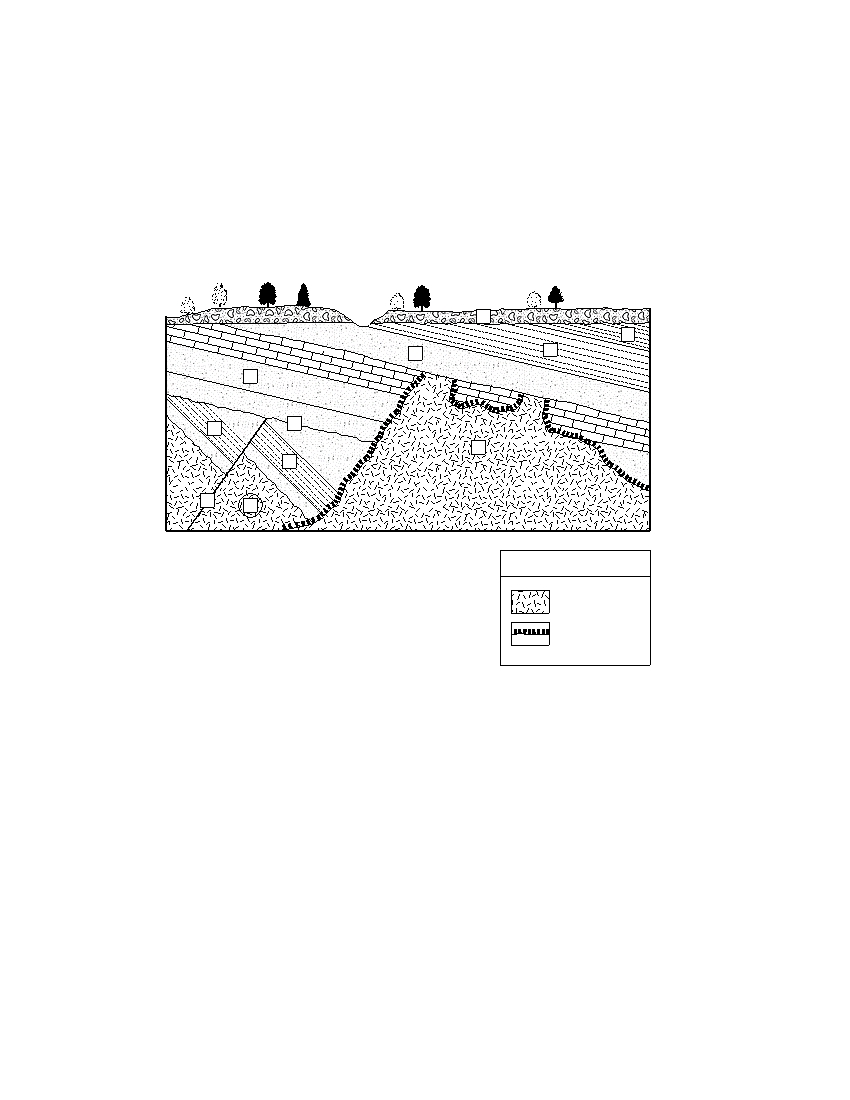
P HYSICAL S ETTING/ E ARTH S CIENCE – continued
62 [1] Allow 1 credit for circling letter I .
63 [1] Allow 1 credit if the center of the X is located anywhere in the contact metamorphic zone in the
limestone layer.
Example of a correct response for questions 62 and 63:
A
B
D
C
E
H
G
X
F
H
J
I
Key
Igneous
rock
Contact
metamorphism
64 [1] Allow 1 credit. Acceptable responses include, but are not limited to:
— There is no contact metamorphism shown in rock unit D .
— Rock unit F was eroded, then rock unit D was formed.
— There is a buried erosional surface between F and D .
— Rock unit D is on top of rock unit F .
65 [1] Allow 1 credit. Acceptable responses include, but are not limited to:
— Rock unit H was displaced by movement along a fault.
— Rock unit H was broken when an earthquake occurred.
[7]
[OVER]
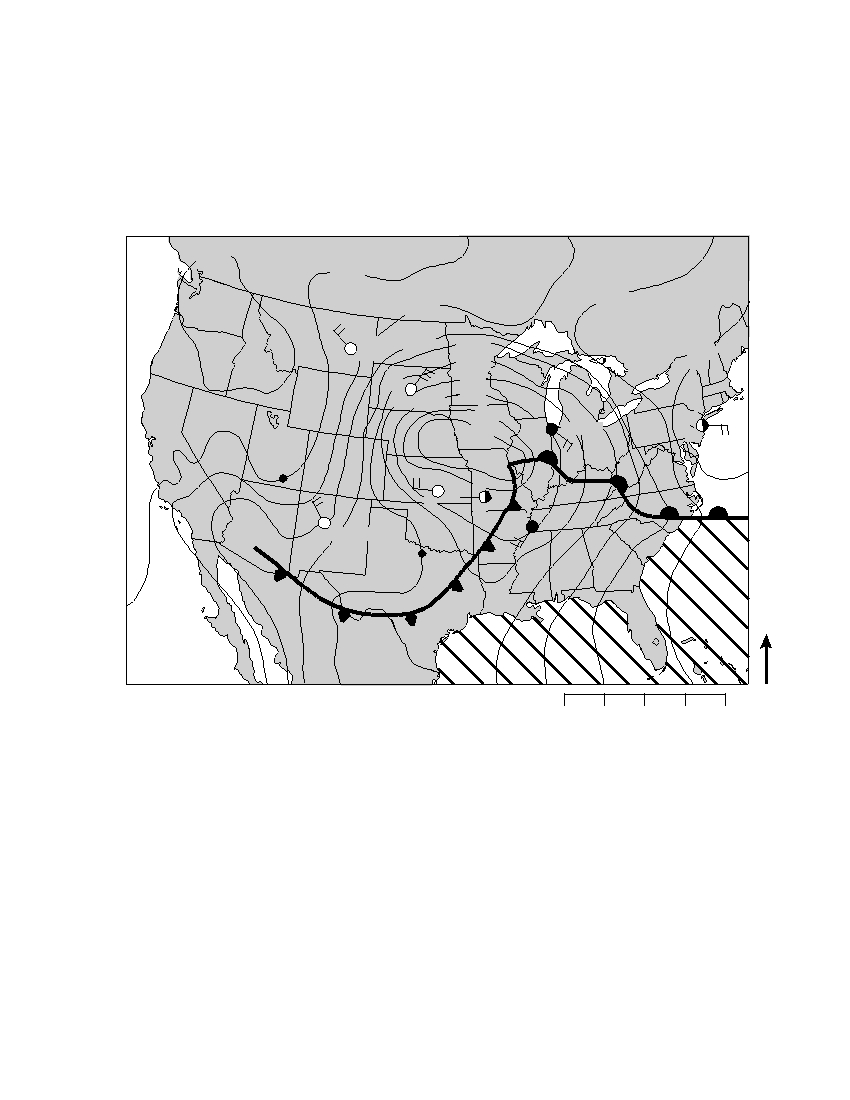
P HYSICAL S ETTING/ E ARTH S CIENCE – continued
Part C
Allow a total of 20 credits for this part. The student must answer all questions in this part.
66 [1] Allow 1 credit if the center of the student’s X is located over the water in the diagonally lined area.
1020
1016
cP
1012
1012
45
Miles
1008
1004
H
City
23
1000
1016
52
996
31 Pierre
992
988
50
984
57
Chicago
54
41
New York
City
A
L
54
57
39
50
55
79
21
Albuquerque
68
B
Atlantic
mT
Ocean
Pacific
Ocean
N
Gulf of Mexico
0
500
1,000 km
67 [2] Allow a maximum of 2 credits, allocated as follows:
— millibars per kilometer
— mb/km
[8]
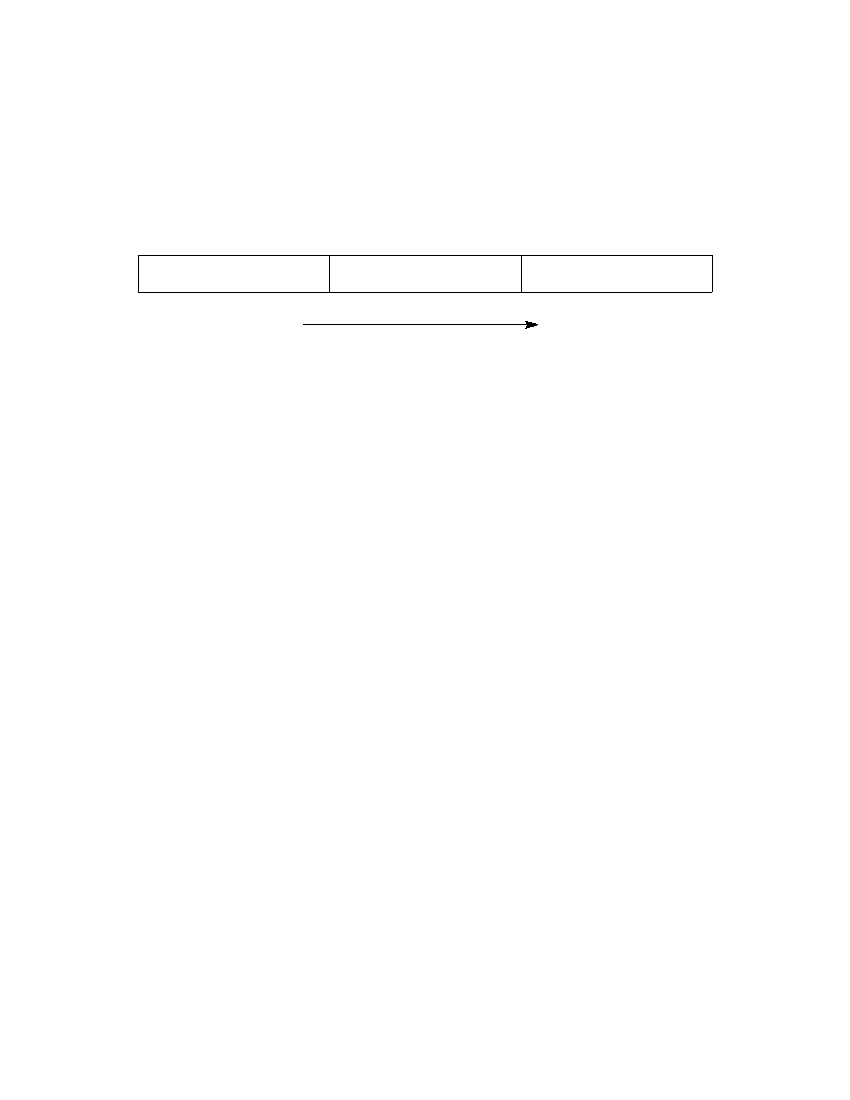
P HYSICAL S ETTING/ E ARTH S CIENCE – continued
68 [1] Allow 1 credit. Acceptable responses include, but are not limited to:
— The isobars are close together between Miles City and Pierre.
— There is a large pressure gradient between Miles City and Pierre.
— The feathers on the station models indicate strong winds in that area.
69 [1] Allow 1 credit.
Albuquerque
New York City
Chicago
Lowest
Highest
Relative Humidity
Relative Humidity
70 [1] Allow 1 credit. Acceptable responses include, but are not limited to:
— inward
— counterclockwise
— counterclockwise and toward the center
71 [1] Allow 1 credit for 11 p.m. Do not allow credit for 11 or 11 a.m.
72 [1] Allow 1 credit. Acceptable responses include, but are not limited to:
— Earth rotates at a rate of 15°/hr.
— Earth’s period of rotation is 24 hours.
— Earth spins 360° in 24 hours.
[9]
[OVER]
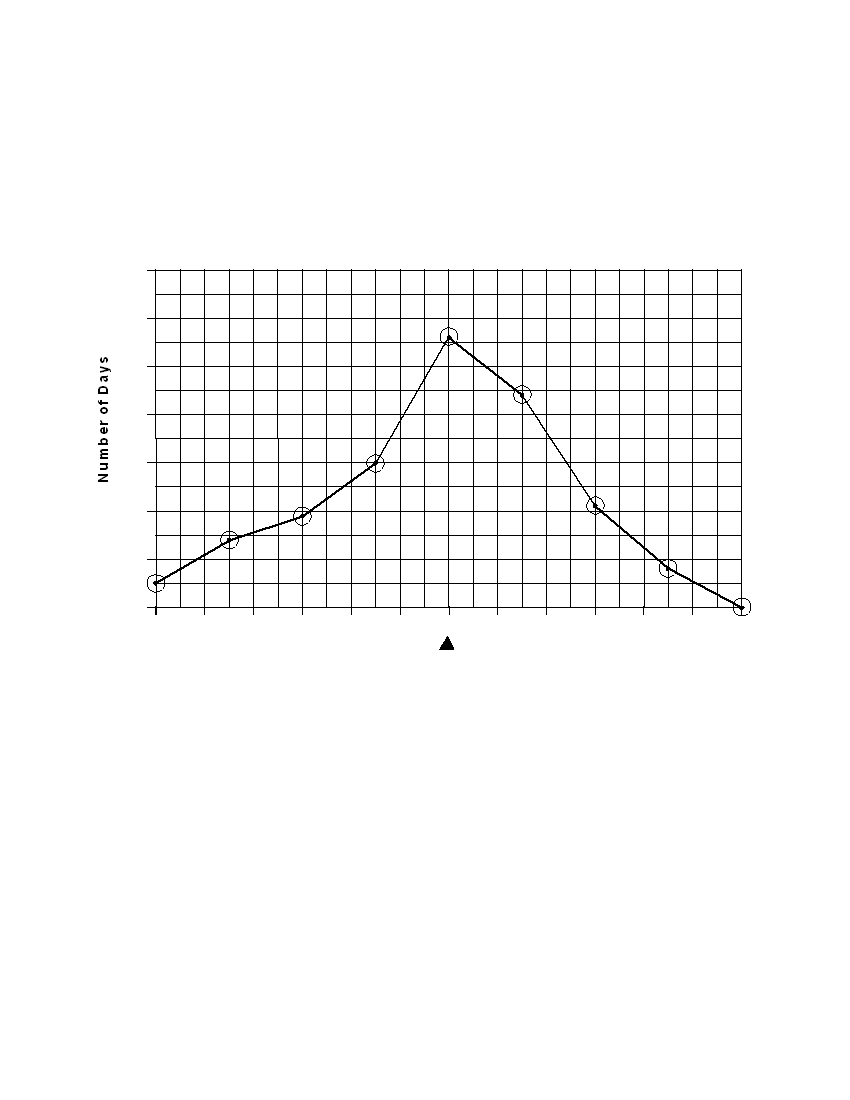
P HYSICAL S ETTING/ E ARTH S CIENCE – continued
73 [1] Allow 1 credit if the centers of eight or nine X s are within the circles shown on the graph and are
correctly connected with a line that passes through the circles.
Note: An overlay should be used to rate this graph.
Example of a 1-credit response:
Average Number of Days a Thunderstorm Occurs Over Land
70
60
X
50
X
40
30
X
20
X
X
X
10
X
X
0
X
60°
50°
40°
30°
20°
10°
0°
10°
20°
30°
40°
50°
60°
North Latitude
Equator
South Latitude
74 [1] Allow 1 credit. Acceptable responses include, but are not limited to:
— As latitude increases, the number of days with thunderstorms decreases.
— Lower latitudes have more thunderstorms.
— an inverse relationship between latitude and number of days with thunderstorms
[10]

P HYSICAL S ETTING/ E ARTH S CIENCE – continued
75 [1] Allow 1 credit for evaporation.
76 [1] Allow 1 credit. Acceptable responses include, but are not limited to:
— Condensation is the phase change from water vapor (gas) to water (liquid).
77 [1] Allow 1 credit. Acceptable responses include, but are not limited to:
— The soil is saturated.
— Rate of rainfall exceeds the rate of infiltration.
— The ground is frozen.
— The land has a steep slope.
78 [1] Allow 1 credit. Acceptable responses include, but are not limited to:
— Plants release water into the air by transpiration.
— Runoff is slowed by plants, so more infiltration can occur.
79 [1] Allow 1 credit for 80 calories/gram.
80 [1] Allow 1 credit. Acceptable responses include, but are not limited to:
— moraines
— grooved bedrock
— scratched bedrock
— polished bedrock
— U-shaped valleys
81 [1] Allow 1 credit for 24 hours.
[11]

P HYSICAL S ETTING/ E ARTH S CIENCE – concluded
82 [1] Allow 1 credit if both latitude and longitude are correct.
Latitude: 80° S
Longitude: 120° W
83 [1] Allow 1 credit. Acceptable responses include, but are not limited to:
— unsorted
— mixed
— not in layers
84 [1] Allow 1 credit. Acceptable responses include, but are not limited to:
— snow removal by wind
— decreased rate of ice flow
— increased melting
— global warming
— iceberg formation
— decreased snowfall
[12]

Regents Examination in Physical Setting/Earth Science
January 2008
Chart for Converting Total Test Raw Scores to
Final Examination Scores (Scaled Scores)
The Chart for Determining the Final Examination Score for the January 2008
Regents Examination in Physical Setting/Earth Science will be posted
on the Department’s web site http://www.emsc.nysed.gov/osa/ on
Wednesday, January 23, 2008. Conversion charts provided for previous
administrations of the Regents Examination in Physical Setting/Earth
Science must NOT be used to determine students’ final scores for this
administration.
Submitting Teacher Evaluations of the Test to the Department
Suggestions and feedback from teachers provide an important contribution to the test
development process. The Department provides an online evaluation form for State
assessments. It contains spaces for teachers to respond to several specific questions and to
make suggestions. Instructions for completing the evaluation form are as follows:
1. Go to www.emsc.nysed.gov/osa/exameval.
2. Select the test title.
3. Complete the required demographic fields.
4. Complete each evaluation question and provide comments in the space provided.
5. Click the SUBMIT button at the bottom of the page to submit the completed form.
[13]
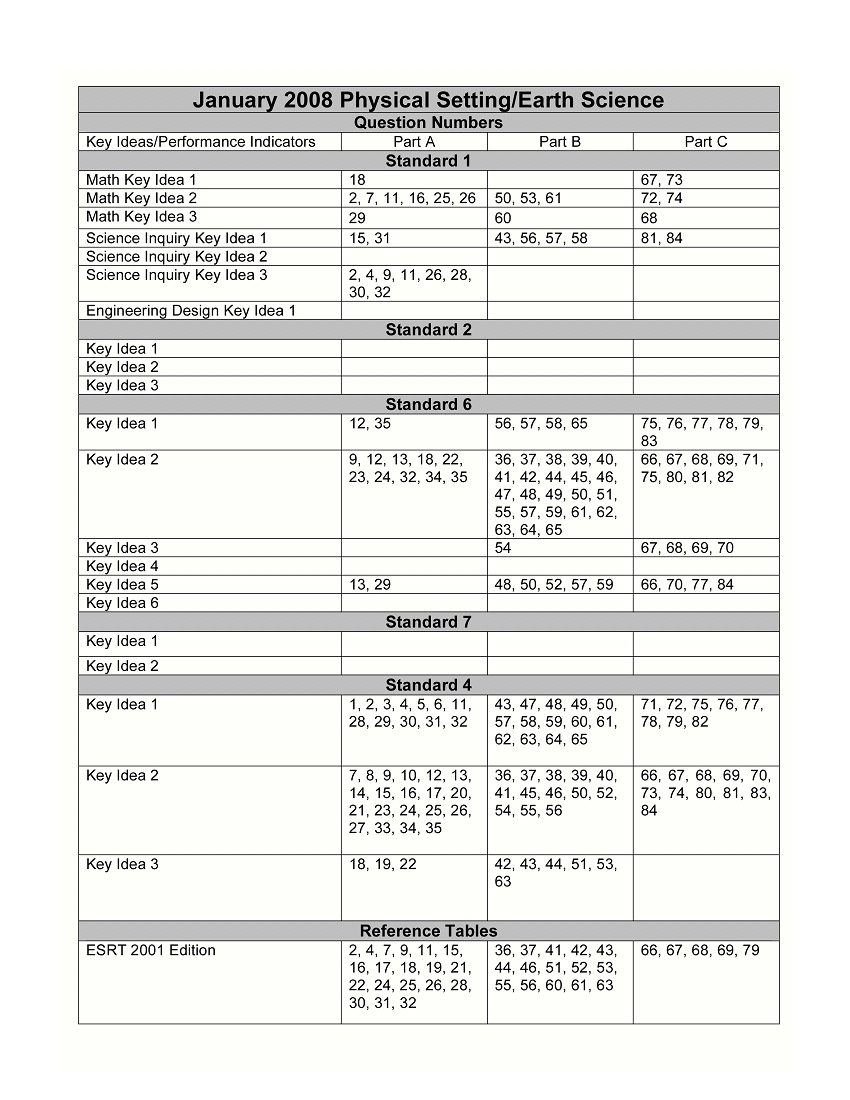
Map to Core Curriculum
[14]

